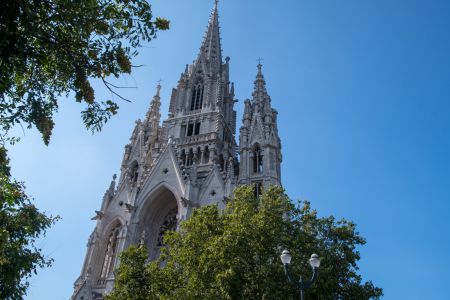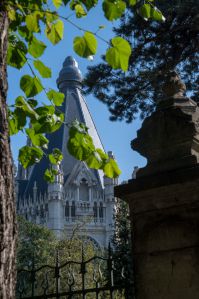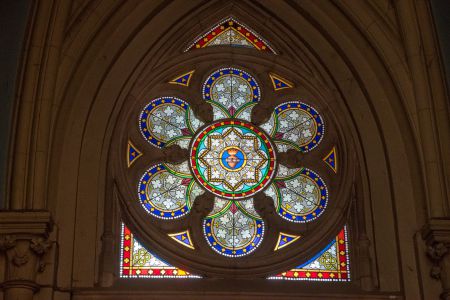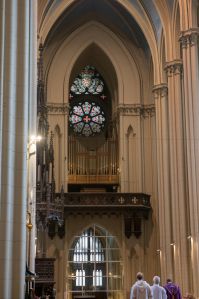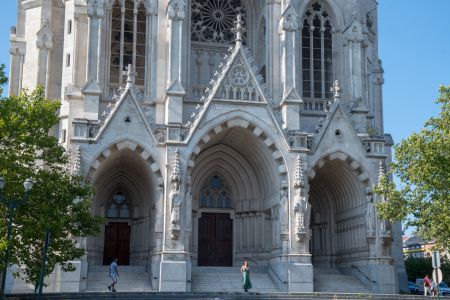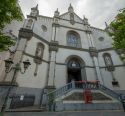Church | 1854-1872 | Neogothic | Catholic Church



Map
Opening hours
02 January - 31 January
Mon -
Tue 14.00 - 17.00
Wed 14.00 - 17.00
Thu 14.00 - 17.00
Fri 14.00 - 17.00
Sat 14.00 - 17.00
Sun -
01 February - 30 November
Mon -
Tue 14.00 - 17.00
Wed 14.00 - 17.00
Thu 14.00 - 17.00
Fri 14.00 - 17.00
Sat 14.00 - 17.00
Sun 14.00 - 17.00
The Royal Crypt is open one Sunday a month from 2pm to 5pm: check the dates.
The church is illuminated in the evening.
Guided tour
artndl.kunstolvl@ndlaeken-olvlaken.be
Religious offices
Wednesday and Friday : mass at 5.30 pm (Fr) preceded by adoration of the Blessed Sacrament at 5 pm
Saturday : 5.00 am (Fr)
Sunday : 11.15 am (Fr) - 1 pm (in Albanian)
Description
Just two paces from the royal palace of Laeken, the church, which is on a small remodelled square, is a Neo-Gothic building which is worth a visit, above all, for its close association with the royal family.
It was built on the instigation of Leopold I, following the death of Queen Marie-Louise in 1850, after plans by the architect Poelaert. The church was consecrated in 1894 but only completed in 1909.It shelters the crypt where members of the royal family are buried.
In the choir of the church, which is no longer used for services, there is a permanent exhibition dedicated to the life and works of Cardinal Joseph Cardijn, the founder of the “Young Catholic Workers”. He was vicar at Laeken and started his action here for the emancipation of working class youths.
Also in the church is a bust of Monseigner Van Waeyenbergh, from Laeken and the rector of the University of Louvain during the 1940-45 war. There is a polychrome, Romanesque statue of the Virgin in wood, the cult of the Virgin being very much alive here for a long time. One came on pilgrimage here to pray to Our Lady to console the afflicted and to ask for good weather for crops.
The neighbouring cemetery is also visited by those interested in funeral art. It contains many graves of well known 19th century personalities.
Photos
Media
Remarkable elements
Royal crypt
The Royal Crypt in the Church of Our Lady of Laeken is the burial place of all reigning Belgian sovereigns and their wives, as well as some members of the Belgian royal family.
Organ Schijven-Van Bever (1874-1912)
The great organ of the Church of Our Lady of Laeken was built between 1872 and 1874 by Pierre Schyven and inaugurated in the presence of King Leopold II by Alexandre Guilmant and Auguste Mailly.
Dismantled in 1908 by the Laeken organ builder Salomon Van Bever, it was rebuilt in 1911 with the addition of a Positif. On May 10, 1912 a solemn concert given by Louis Debond closed the work.
In 1975 the Ministry of Public Works decided to restore the instrument. The Schyven-Van Bever organ in the Church of Our Lady of Laeken is one of the most prestigious examples of romantic organ building in Belgium.
Neo-Gothic choir organ (Van Bever, 1907)
The choir organ was built in 1907 by Van Bever Frères and restored in 1996 by Étienne De Munck. It allows a perfect and harmonious playing with the great organ.
Tomb of Cardinal Leon-Joseph Cardijn (1882-1967)
Son of a Flemish coalminer, Léon Joseph Cardijn became a priest and formed a group of young Christian workers in his parish near Brussels. In 1924, in line with the encyclical Rerum Novarum, he created the Catholic Worker Youth (YCW), which was to have a great international influence throughout the 20th century. The tomb of the cardinal is located in the church of Our Lady of Laeken.
Choir
Although the old church was demolished in 1894 due to its advanced state of decay, the choir was preserved and survived as a chapel in the center of the cemetery adjacent to the new church.
Source : Wikipedia
Cemetery of Laeken
The cemetery of the former commune of Laeken in Brussels is the oldest of the Brussels cemeteries still in use. It is also the most internationally known for the richness of the funerary heritage it contains.
It is also the last cemetery in the Brussels region of the "parish" type, established around a church following the ancient Christian custom of burying the dead near the living.
The statuary is the work of the most prominent sculptors of the time, such as the funerary monument of Louis-Joseph Ghémar by the sculptor Albert-Ernest Carrier-Belleuse, master of Rodin. A copy of Rodin's Thinker is on the tomb of Joseph Dillen, an art dealer.
Many monuments were made in the workshop of the sculptor and stonecutter Ernest Salu (1845-1923) and his sons.
Source : Wikipedia



